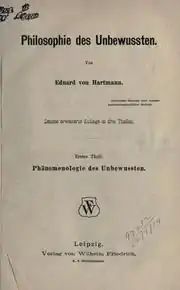Philosophy of the Unconscious
Philosophy of the Unconscious: Speculative Results According to the Induction Method of the Physical Sciences (German: Philosophie des Unbewussten) is an 1869 book by the philosopher Eduard von Hartmann.[1] The culmination of the speculations and findings of German romantic philosophy in the first two-thirds of the 19th century, Philosophy of the Unconscious became famous.[2] By 1882, it had appeared in nine editions.[3] A three volume English translation appeared in 1884.[4] The English translation is more than 1100 pages long.[5] The work influenced Sigmund Freud's and Carl Jung's theories of the unconscious.[4][6]
 | |
| Author | Eduard von Hartmann |
|---|---|
| Original title | Philosophie des Unbewussten |
| Translator | W. C. Coupland |
| Country | Germany |
| Language | German |
| Subject | Unconscious mind |
| Published |
|
| Media type | Print (Hardcover and Paperback) |
| ISBN | 978-1440050282 |
Reception
Philosophy of the Unconscious was translated from German into French and English, and went through many editions in all three languages, exerting a great influence on European culture and helping to make the idea of the unconscious familiar and accepted by the close of the 19th century.[7] The work was widely read.[8] Philosophy of the Unconscious received a critical discussion in the philosopher Franz Brentano's Psychology from an Empirical Standpoint (1874); Brentano commented that Hartmann's definition of consciousness perhaps referred to "something purely imaginary" and certainly did not agree with his definition of consciousness.[9]
The philosopher Friedrich Nietzsche described Hartmann's book as a "philosophy of unconscious irony", in his On the Use and Abuse of History for Life, one of the essays included in Untimely Meditations (1876). In Nietzsche's words: "Take a balance and put Hartmann's 'Unconscious' in one of the scales, and his 'World-process' in the other. There are some who believe they weigh equally; for in each scale there is an evil word—and a good joke."[10]
Hartmann's work has been seen as preparing the way for Freud's later theory of the unconscious.[4] Freud consulted Philosophy of the Unconscious while writing The Interpretation of Dreams (1899),[6] in which he called Hartmann the firmest opponent of the theory that dreams are wish fulfillments.[11] The philosopher Hans Vaihinger was influenced by Philosophy of the Unconscious, relating in his The Philosophy of 'As if' (1911) how it led him to Schopenhauer.[12] The psychiatrist Henri Ellenberger writes in The Discovery of the Unconscious (1970) that the main interest of Hartmann's work is not its philosophical theories, but its wealth of supporting material.[2]
The psychologist Hans Eysenck writes in Decline and Fall of the Freudian Empire (1985) that Hartmann's version of the unconscious is very similar to Freud's.[5] The philosopher Roger Scruton described Philosophy of the Unconscious as the "first major treatise" about the unconscious in Sexual Desire (1986). He credited Hartmann with offering a "canny and vigorous" description of sexual desire, but nevertheless considered him unsuccessful in explaining its intentionality.[13] John Kerr writes that Hartmann's ideas about "destruction and transformation" parallel those of psychoanalyst Sabina Spielrein.[14] The Italian poet Giovanni Pascoli was influenced by Philosophy of the Unconscious in his poetics program, "Il fanciullino" ("The child", 1897).[15]
English translation
The first English translation by W. C. Coupland[16] was published in 1884, with the title Philosophy of the Unconscious, a literal translation of the German title. It is currently available as a reprint with the same title.[17]
See also
References
- Full title "Philosophie des Unbewussten: Speculative Resultate nach inductiv-naturwissenschaftlicher Methode (speculative results according to the inductive method of physical science) (original sub-title in 1st edn 1869: Versuch einer Weltanschauung): cited by Sebastian Gardner, "Eduard von Hartmann's Philosophy of the Unconscious, chapter 7 of "Thinking the Unconscious, Nineteenth-Century German Thought", ed. Nicholls and Liebscher, Cambridge University Press, 2010.
- Ellenberger, Henri F. (1970). The Discovery of the Unconscious: The History and Evolution of Dynamic Psychiatry. New York: Basic Books. pp. 209–210. ISBN 0-465-01672-3.
- Dufresne, Todd (2000). Tales from the Freudian Crypt: The Death Drive in Text and Context. Stanford: Stanford University Press. p. 88. ISBN 0-8047-3885-8.
- Stack, George J. (1999). Audi, Robert (ed.). The Cambridge Dictionary of Philosophy. Cambridge: Cambridge University Press. p. 363. ISBN 0-521-63722-8.
- Eysenck, Hans (1986). Decline and Fall of the Freudian Empire. Harmondsworth: Penguin Books. p. 33. ISBN 0-14-022562-5.
- Sulloway, Frank (1979). Freud, Biologist of the Mind: Beyond the Psychoanalytic Legend. London: Burnett Books. p. 253. ISBN 0 233 97177 7.
- Stevens, Anthony (1991). On Jung. London: Penguin Books. p. 12. ISBN 0-14-012494-2.
- Smith, Roger (1997). The Norton History of the Human Sciences. New York: W. W. Norton & Company. p. 401. ISBN 0-393-31733-1.
- Brentano, Franz (1995). Psychology from an Empirical Standpoint. London: Routledge. p. 104. ISBN 0-415-10661-3.
- Friedrich Nietzsche, On the Use and Abuse of History for Life, trans. (revised edition 2010) by Ian Johnston.
- Freud, Sigmund; Robertson, Ritchie (1999). The Interpretation of Dreams. Oxford: Oxford University Press. p. 106. ISBN 0-19-210049-1.
- Vaihinger, Hans (1968). The Philosophy of 'As If'. Fakenham: Cox & Wyman. p. xxviii.
- Scruton, Roger (1994). Sexual Desire. London: Phoenix. pp. 194–195. ISBN 1-85799-100-1.
- Kerr, John (2012). A Dangerous Method. London: Atlantic Books. p. 590. ISBN 978 0 85789 178 5.
- Elio Gioanola, Giovanni Pascoli: sentimenti filiali di un parricida, Jaca Book, 2000, p.18.
- Author of The elements of mental and moral science as applied to teaching, by W. C. Coupland, published London, 1889
- Such as published by Routledge, 2010, ISBN 9780415613866, and by Nabu Press, 2010, ISBN 1146864655